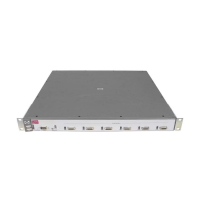Switch Meshing
Operating Notes for Switch Meshing
this condition occurs, the meshed switch that has a blocked link will automat-
ically increase the cost on the external (non-meshed) link to the point where
STP or RSTP will block the external link and unblock the meshed link. This
process typically resolves itself in approximately 30 seconds.
Caution Spanning tree interprets a switch mesh as a single link. Because the switch
automatically gives faster links a higher priority, the default spanning-tree
parameter settings are usually adequate for spanning tree operation. Also,
because incorrect STP or RSTP settings can adversely affect network perfor-
mance, you should not make changes unless you have a strong understanding
of how spanning tree operates.
In a mesh environment, the default RSTP and MSTP timer settings (Hello Time
and Forward Delay) are usually adequate for RSTP or MSTP operation. Because
a packet crossing a mesh may traverse several links within the mesh, using
smaller-than-default settings for the RSTP Hello Time and Forward Delay timers
can cause unnecessary topology changes and end-node connectivity prob-
lems.
For more on spanning-tree, refer to the chapter titled “Spanning-Tree Opera-
tion” in this manual. Also, you may want to examine the IEEE 802.1d, 802.1w,
or 802.1s standards, depending on which version of spanning-tree you are
using.
Filtering/Security in Meshed Switches
Because paths through the mesh can vary with network conditions, configur-
ing filters on meshed ports can create traffic problems that are difficult to
predict, and is not recommended. However, configuring filters on nonmeshed
ports in an edge switch provides you with control and predictability.
IP Multicast (IGMP) in Meshed Switches
Like trunked ports, the switch mesh domain appears as a single port to IGMP.
However, unlike trunked ports, IGMP protocol and multicast traffic may be
sent out over several links in the mesh in the same manner as broadcast
packets.
7-22

